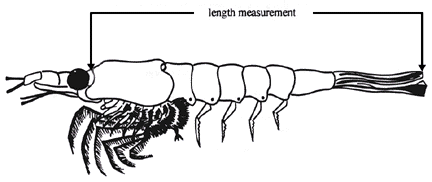

One of the important tools for learning about the biomass
of krill and how it is distributed and "packaged" is bioacoustics.
While on board the R/V Polar Duke, team members use a towed
transducer to survey acoustically for krill and deploy a series of different
sized nets at pre-selected grid stations to collect krill. The onboard echosounder
sends a pulse of sound down into the water, the sound moves through the
water until it reaches something that is different in density, then reflects
back to the receiver. The strength of the signal received is a measure of
its density. Bioaccoustics helps the LTER scientists to "quantify"
how many krill are in the water. Krill often occur in patches (sometimes
these are schools like a fish or aggregations like an insect swarm). Use
of a net alone might turn up only a fraction of the krill in a patch or
the net would not access krill close to the bottom or in underwater valleys.
Bioacoustics also provides information about "packaging" or the
shape, size and depth in the water column of a krill patch. What is the
shape of the krill aggregation? is it a layer (top transect) or a big blob
(bottom transect)? is it a small blob only 100m across or is it 500 m long?
is it deep in the water or is it close to the surface? These sort of differences
might be important to the animals that eat krill, like the penguins!
Antarctic krill release many eggs in the ocean that hatch into larvae, but
just like fish, many of these larval krill die before they reach adulthood.
There is a lot of year to year variability in the mortality rates, however,
and one of the important aspects of the LTER research is trying to understand
what aspects of the environment affect survival of these young krill. Length
frequency distribution, or how often a particular size occurs in the sample
of krill collected is one of the analyses routinely done on the Polar
Duke . When measuring a krill, the LTER scientists have agreed to
use the following standard: total length is from the tip of the rostrum
(the pointy bit between the eyes) and the tip of the uropods (near the end
of the tail) and is measured in millimeters to two decimal places. Body
length is a better indicator for krill in their first 15 months of life
than for an adult krill. Thus, krill measuring between 8.5mm and 20mm were
hatched during the previous austral (January to March) summer. The year-to-year
length distribution data combined with other environmental data (sea ice
variability, weather, adelie penguin and skua population statistics) provide
data sets for scientists to analyze in order to better understand the structure
and function of the antarctic marine ecosystem.
Blackline Master #16
![]()